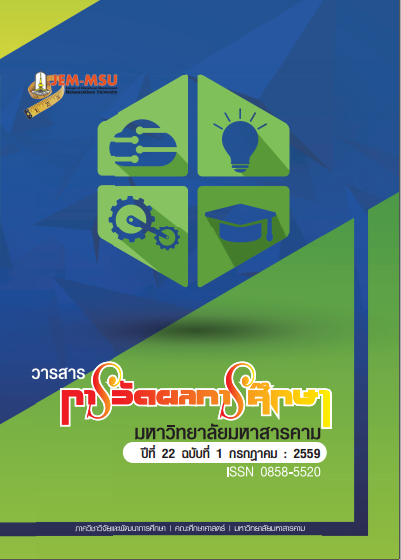Development Of The Computerized Adaptive Testing Program For O-NET At The Grade Nine Level
Main Article Content
Abstract
This research aimed to analyze quality of O-NET examination, prepare Item bank of
O-NET, and develop a computerized adaptive testing system of O-NET. The examination
was provided for grade 9 level including 8 learning substance groups. The computerized
adaptive testing system was generated as a web application. Moreover, the quality of
examination was assessed by using Item Response Theory or IRT with 3 parameters and
Xcalibre Version 4.1.7. The methodologies of this paper were divided into 4 steps as follows:
1) Analyze the quality of O-NET examination for 8 learning substance groups, 2) Prepare the
test bank of O-NET for 8 learning substance groups, 3) Develop the computerized adaptive
testing system, and 4) Evaluate the efficiency of computerized adaptive testing system. The
samples consisted of 30 grade 9 level of Angsilapittayakom School, Chonburi Province. The
research tools included 1) O-NET examination for 8 learning substance groups, and 2) the
computerized adaptive testing system run on a website://www.onetcat.net/onetm3. Then
the students’ satisfaction was assessed by conducting fundamental statistics such as mean
and standard deviation.
The results were represented below.
1. The quality analysis of O-NET examination for 8 learning substance groups
showed that the average difficulty of O-NET examination (b) for grade 9 level was quite high.
2. The Item bank of O-NET was able to contain 4 multiple choices and unlimited
amount depending on size of server. The system also stored 469 items of the O-NET
examination which were analyzed regarding Item Response Theory with 3 parameters. These
items met the selection criteria of all 8 learning substance groups for grade 9 level as well.
3. The efficiency of computerized adaptive testing system of O-NET for grade 9
level was at good level. Besides, it was accepted by experts and samples who had utilized
the program, both general attributes and convenience of usage.
Article Details
The content and information contained in the published article in the Journal of Educational Measurement Mahasarakham University represent the opinions and responsibilities of the authors directly. The editorial board of the journal is not necessarily in agreement with or responsible for any of the content.
The articles, data, content, images, etc. that have been published in the Journal of Educational Measurement Mahasarakham University are copyrighted by the journal. If any individual or organization wishes to reproduce or perform any actions involving the entirety or any part of the content, they must obtain written permission from the Journal of Educational Measurement Mahasarakham University.


